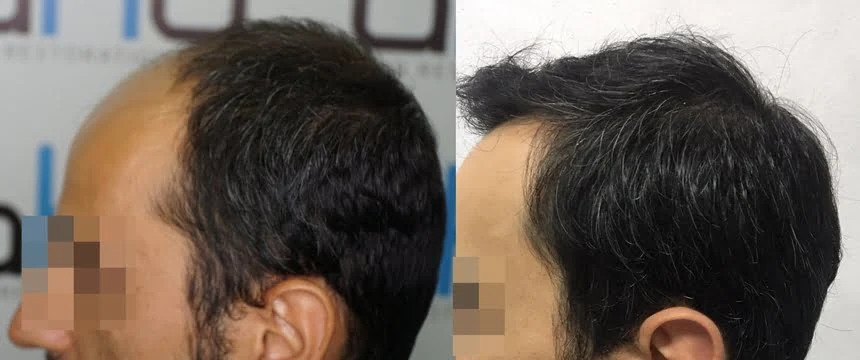The area between the eye, ear, and cheekbone (temporal bone) is called the temple or the sideburn area. A hair transplant to be performed on the temples has certain unique characteristics and rules. We believe that after reading our article, you will have comprehensive knowledge about this subject.
The temple area is an important detail that masks the width of the face. This is because the transition between the forehead and the side hair becomes softer, allowing the facial area to stand out more prominently. However, when the temple hair begins to thin and recede, the width of the forehead becomes noticeably apparent, which can cause people to be perceived as older.
Hair transplants for the temples, forehead, and sideburn areas are often performed together. For regional hair transplants, such as in Norwood type 2 and 3, including the temple area will be more appropriate for a natural appearance. Otherwise, achieving a natural look can be difficult, as the face may appear wider.
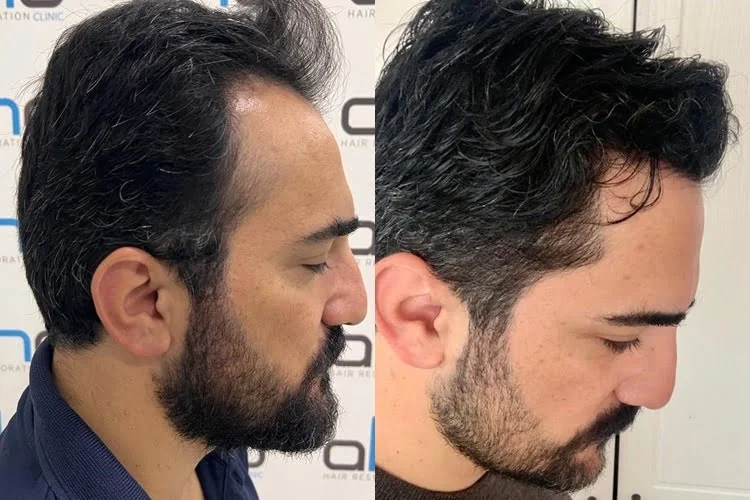
If we were to list the causes of hair loss in the temple region:
- Androgenetic alopecia (male pattern hair loss) usually starts at the temples, and this is a significant sign of androgenetic alopecia.
- Natural recession of the temporal hairline due to aging.
- Traction alopecia, especially in women, caused by pulling on the hair.
- Possible causes include nutritional deficiencies, autoimmune, and hormonal diseases.
Symptoms of Hair Loss in the Temple Area
Hair loss in the temple region usually begins with minimal changes and can progress proportionally with advancing age to complete baldness in this area. The reason for this is androgenic hair loss. During this process, the following symptoms may be observed:
- Recession of the front hairline in an M-shape.
- Thinning, sparseness of the temple hair, and recession of the side hairline.
- A noticeable difference in color tone between the hair in this area and the rest of the hair.
Staging
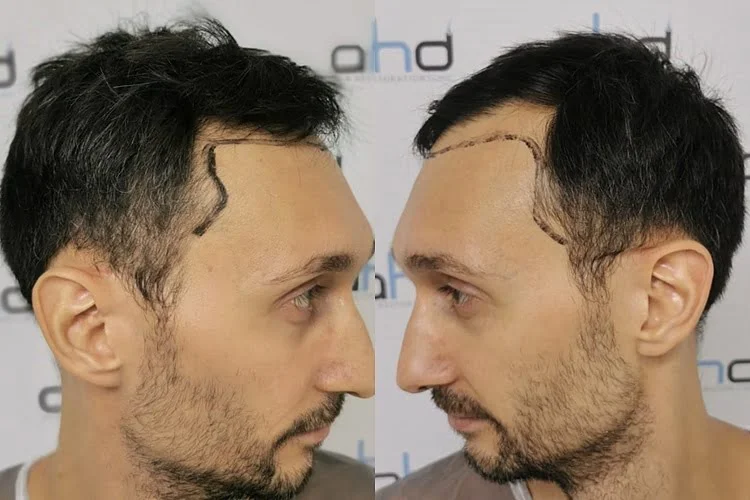
Hair loss in this region can be examined in 4 stages, based on its severity. These stages are as follows:
- Stage 1: There is no recession in the lateral hair, and the sharpness of the hairline is intact.
- Stage 2 (Slight Recession of the Hairline): The triangular appearance in the temple region is still clearly visible. However, partial thinning and sparseness have begun in the hair strands in this area.
- Stage 3 (Moderate Recession): The convex angle of the temporal triangle decreases, and the sharpness of the lateral hairline begins to disappear. This stage generally corresponds to Norwood Type 3 hair loss.
- Stage 4 (Advanced Recession of the Hairline): The temporal triangle has completely disappeared. In fact, the angle, which is normally convex, has become concave. This is more common in Norwood 4 and more severe cases of hair loss. Especially in advanced hair loss types like Norwood 6-7, the temporal triangle completely disappears and becomes concave.
Who is a Good Candidate for Temple Hair Transplantation?
This procedure can generally be an effective and permanent solution for the following candidates, provided their general health condition is suitable.
- Individuals who have a sufficient number of donor hair follicles for a frontal hairline and vertex (crown) hair transplant.
- Men who have had a transplant before but have empty temples. If the temples remain empty, it can result in an artificial look.
- Men and women with a receding forehead and frontal hairline. These individuals typically have a high forehead.
- Individuals, especially those in the early stages of hair loss, such as Norwood types 2 and 3, are ideal candidates. This group includes those with an M-shaped hairline.
- People whose temple hair and the triangular section have not completely disappeared but have thinned out.
- Transsexual individuals.
How is Temple Hair Transplantation Performed?
It is more or less the same as other hair transplant procedures applied to the temples. It is generally more appropriate to perform it together with a hair transplant to the forehead area and the frontal hairline, as in Norwood 2-3 cases.
- Consultation: Based on the examination of the donor area, your doctor will decide whether you are a suitable candidate for the operation.
- Front and Side Hairline Planning: A temple hairline is designed to suit the individual’s facial structure. This is an important stage for achieving a natural appearance.
- Graft Collection: After local anesthesia, hair grafts are individually collected from the donor area using the FUE method. If the required number of grafts is not too high, the No-Shave FUE technique can also be preferred. Grafts can also be obtained using the FUT technique. However, at AHD clinic, the graft collection procedure is performed only with the FUE method.
- Graft Placement: Small incisions are made in the recipient area, and the grafts are transplanted into their new locations. At AHD clinic, the DHI technique is used for graft placement due to its many advantages. The DHI technique uses hair implant pens, known as implanter pens. This makes it possible to achieve a very natural result.
5 Essential Rules for a Natural Temple Transplant

Hair transplantation to the temples is a procedure that requires special expertise and experience. This is because the grafts must be placed in this area at the correct angle and depth so that the transplanted grafts mimic the person’s natural hair growth pattern. Furthermore, the temporal hairline must be designed correctly, as this area has its own distinct sharp angles and natural structure. If a random hair transplant is performed without knowledge of these factors, an unsuccessful and unnatural result is inevitable. Therefore, for a correct and successful temple hair transplantation, the following 5 rules must be applied. These are:
- Temporal hairline planning
- Hair exit angle (Hair emergence angle)
- Hair direction
- Fine and single grafts
- Ideal density
Now, we will look in detail at 5 important rules that must be followed during a temple hair transplant.
1- Hairline Planning
Each person’s facial structure is different from one another. The point, angle, and width of the temporal triangle should be proportional and harmonious with the individual’s facial structure. An excessively narrow or wide temporal triangle can disrupt the natural appearance. While drawing this line, the following anatomical points help us in people who have lost the triangular image:
- Tip of the nose and
- Midpoint of the pupil
- Tip of the earlobe
- Midpoint of the frontal hairline
In the following image, you see a hairline drawn taking these points into consideration.

Taking these points into consideration, two imaginary lines are drawn.
- It passes through the tip of the nose and the pupil midpoint and continues towards the frontal hairline and the temporal hairline. (The line passing through points 1 and 2)
- It is located between the midpoint of the frontal hairline and the earlobe. (The line passing through points 3 and 4)
When these two lines are connected, they form a triangular area. This area is the temporal region, which is called the temporal triangle.
The goal here is to create an aesthetic appearance between the forehead height and the side hairline. This aesthetic outcome depends entirely on the artistic skill of the surgeon who will perform your hair transplant. Therefore, we recommend that you have a hair transplant for the temples done by a doctor who is experienced in this specific area. If a temple hairline is created haphazardly without knowledge of these anatomical points, an artificial look is inevitable.
2- The angle at which your hair grows out
All grafts to be placed in the temple region must be slanted, parallel to the scalp. In other words, when the channel is opened, the incisions should be made as if they are almost flush with the skin.
The exit angle of the natural hair in this area is between 5-10 degrees. Therefore, this angle rule must be strictly followed during the transplantation.
3- Hair Part
This is also crucial for a natural temple result. The direction of the hair at the top of the triangle points downward and inward. The direction of the hair at the bottom of the triangle points downward and is parallel to the line. As you approach the sideburn area, which is the junction point, the direction should point completely downward. This way, a natural integration with the person’s original hair can be achieved.
4 – Thin and Single Hair Grafts
The natural hairs in this area are fine and single. Therefore, the finest and single grafts from the donor area should be used in this region. If there are multiple grafts, they must be separated into single hair follicles before transplantation. Even if multiple grafts are planted in the inner part of the temporal triangle, their number should not be excessive. To achieve fine hair, the roots above the ear should be preferred. Because in hair transplantation to the temples, the hair from above the ear is very compatible in terms of color tone match and fineness.
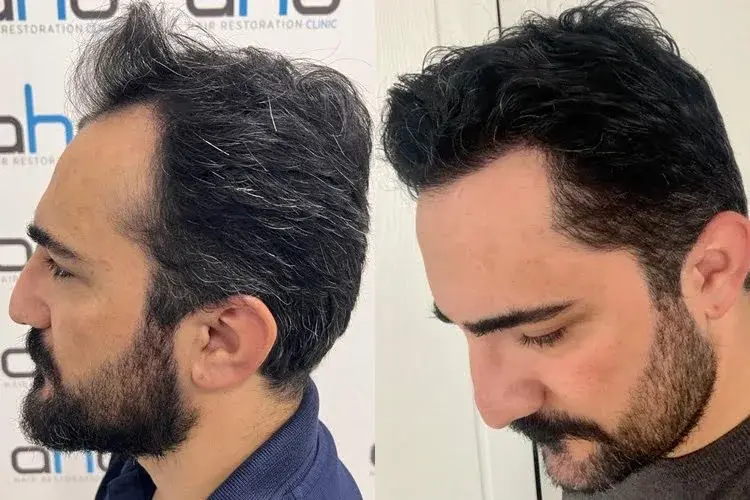
IMPORTANT:
It would never be correct to use beard hair as a donor in the temple area. Because using beard hair will absolutely not create a natural appearance in this area. However, it might make sense to use the finer chest hair for temple hair transplantation.
5- Density
Placing an excessive number of grafts per 1 cm2 disrupts naturalness. This is because the hairs in this region will already lie parallel to the skin, so even a small number of grafts can cover each other and provide a normal density. In the temple region, an ideal density can be achieved with 20-30 single grafts per 1 cm2.
When performing a hair transplant on the temples, the 5 rules mentioned above must be strictly followed, as they are essential for a successful and natural result. Otherwise, the probability of disappointment is high.
For these reasons, if you are considering a temple hair transplant, you need to do your research and find a reputable and experienced doctor. We highly recommend that you review the before-and-after photos of the temples from the clinics you are considering. In fact, due to the complexity of the procedure, it is not advisable for a clinic without specific experience to perform temple hair transplants.
At AHD Clinic, we always perform hair transplants by adhering to these 5 rules.
Recovery Process
The recovery process for a transplant performed in the temple area is no different from a classic hair transplant. During this process, expected and completely normal complications such as redness, swelling, acne, and shock loss will also occur. Therefore, the post-operative care instructions you need to follow after a hair transplant apply here as well.
The most important point to pay attention to during the recovery period is the lying position. If a transplant has been performed in the temple area, you must absolutely avoid sleeping on your side for the first 10 days. Otherwise, during sleep, the grafts may rub against the pillow due to contact. This can cause the transplanted grafts to become dislodged or damaged. Therefore, for the first 10 days, it is recommended that you use a neck pillow, commonly known as a travel pillow, while sleeping.
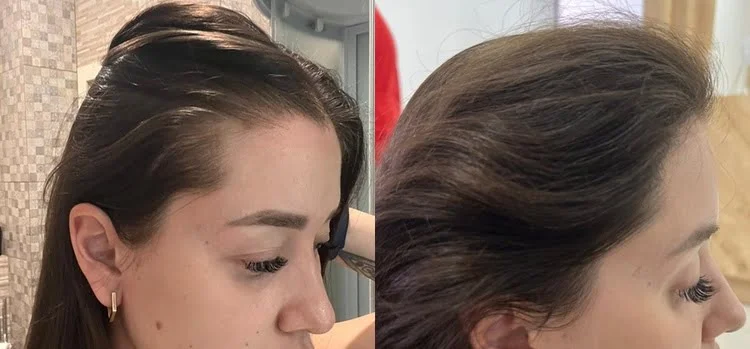
Shock hair loss occurs in this area 2-3 weeks later. After the shock loss, the shed hairs begin to regrow and start growing again after 3-4 months. By the 7th and 8th months, a large portion of the hair will have grown out. For the definitive desired result in the temple area, 9-12 months are necessary.
Temple hair transplant for women
Women who do not have widespread hair loss but have a receding hairline are ideal candidates for temple hair transplantation. Unlike men, women do not have a sharp triangular recession in the hair at the temple area. The hairline in this area is relatively more rounded and has a softer transition.
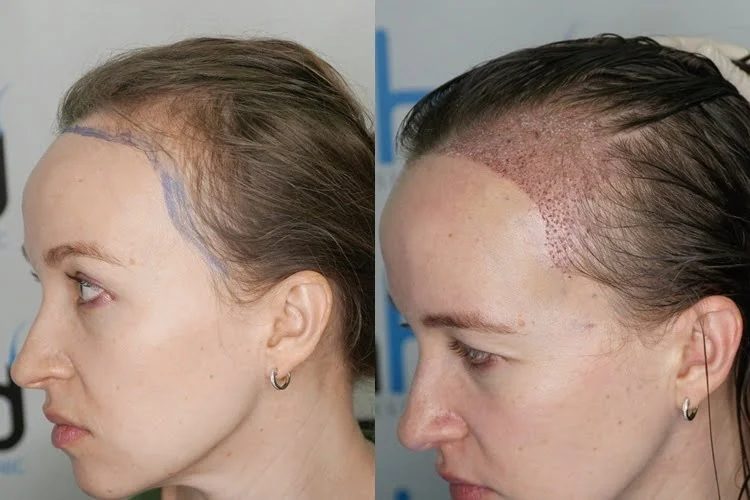
The 5 important rules we mentioned above for a natural temple hair transplant also apply exactly to women. In other words, the grafts to be implanted in the temple area must be entirely single and fine. Furthermore, the angle and direction rules must be strictly followed for a natural result.

Temple Hair Transplant at AHD Clinic
For every person who applies to our clinic, a hair transplant is performed according to the following plan.
- Based on the photos you send, it is first determined whether each individual, male or female, is suitable for a hair transplant.
- If a hair transplant is also planned for the temple areas, a temple and frontal hairline suitable for the facial structure is designed.
- To ensure a natural appearance, the 5 rules we mentioned before are meticulously applied to every patient without exception.
- The DHI method also has many advantages for temple transplants. It is easier to place the hair grafts at the correct angles.
- Our goal is a result that, when viewed from the outside, is absolutely undetectable by others.
- The post-operative process is explained to the patient in detail after the operation is complete. We provide all kinds of support to our patients until the one-year mark, when the final result is expected. You can always reach us via WhatsApp, phone, or email.
Contact AHD clinic for temple hair transplant
Yüz yapınıza uygun bir saç çizgisiyle doğal saçlara kavuşmak mümkündür.
How many grafts are required to fill in the temples?
The total number of hair follicles required for the right and left temples can vary between 400 and 1000. For Norwood type 3 hair loss, 300-500 hair follicles may be sufficient. It is not correct to transplant a high number of grafts into the temples of Norwood 7 individuals, whose temporal triangular line has completely disappeared. This is because the balding area is large, and the number of grafts that can be taken from the donor area will not be high. Therefore, it would not be logical to use a significant portion of these grafts on the temple area.
How long does a temple hair transplant take?
A transplant focusing only on the temples can take 1-2 hours depending on the number of grafts. However, when this procedure is typically performed with the front hairline and other areas, this duration varies depending on the number of grafts.
What advantage does temple hair transplantation provide?
If a successful hair transplant is performed towards the temple regions:
While the M or W-shaped frontal hairline is corrected, the temples are also transplanted. This contributes to a natural appearance in facial aesthetics. Thus, the person’s aged appearance perception is eliminated, and they gain longer-looking natural hair. This situation leads to an increase in self-confidence.
How much does temple hair transplant cost?
AHD Clinic does not have a separate pricing policy for transplants performed in this area (beard and mustache). The prices applied in classic hair transplantation are also valid here. Criteria such as the doctor’s brand value, geographical location, and the number of grafts are also applicable here. For detailed information on hair transplant prices in Turkey, you can refer to the relevant article.
In the United States, you can expect a price quote between $5,000 – $20,000 for a hair transplant to be applied to the beard area.
Can hair loss at the temples be prevented?
The cause of hair loss in this region is largely androgenic in origin. That is, it is a sign of male pattern baldness. Therefore, the use of Finasteride can significantly prevent hair loss in the temples. Additionally, topical Minoxidil use and PRP treatment can be effective for thickening and strengthening the hair in this area.
Will there be a scar after temple transplantation?
If the incisions to be made are large, there is a possibility of scarring. The grafts to be implanted in this area must be entirely single. Therefore, if an implanter with a diameter of 0.6 – 0.8 mm is used with the DHI method, the possibility of scarring is almost nonexistent, and a natural appearance can be achieved.
Why is temple hair transplantation difficult?
Yes, it is difficult. Because it is necessary to make incisions parallel to the skin at 5-10 degree angles and apply the 5 important rules mentioned above. Furthermore, designing a technically correct facial symmetry requires special expertise. A temple transplant performed without correctly applying the angle and direction rules will never achieve a natural appearance. Additionally, the color tone of the transplanted hair must be compatible with the hair in this region.

